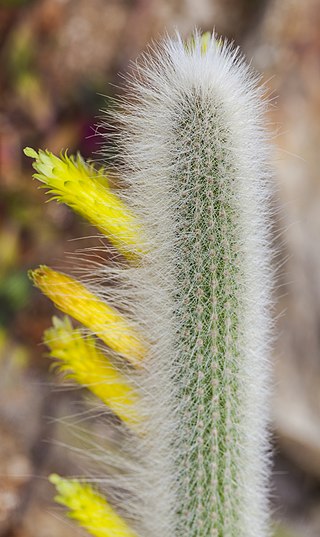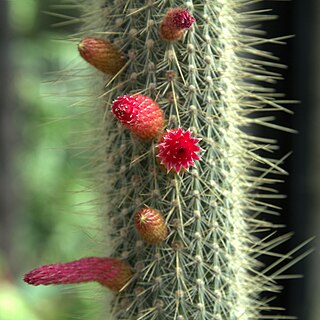
Cleistocactus strausii, the silver torch or wooly torch, is a perennial flowering plant in the family Cactaceae. It is native to mountainous regions of Department Tarija, Bolivia, at 1,500–3,000 m (4,921–9,843 ft).

Samaipaticereus is a monotypic genus of cactus containing the sole species Samaipaticereus corroanus. It is known only from East Andean Bolivia and Peru.

Yungasocereus is a monotypic genus of cacti. Its sole species is Yungasocereus inquisivensis, native to Bolivia.

Cleistocactus winteri is a succulent of the family Cactaceae. Its common name is the golden rat tail. Cleistocactus winteri subsp. colademono, as its synonym Cleistocactus colademononis, has gained the Royal Horticultural Society's Award of Garden Merit.

Uebelmannia gummifera is a species of plant in the family Cactaceae. It is endemic to Brazil. Its natural habitat is dry savanna. It is threatened by habitat loss.

Cleistocactus hyalacanthus is a species of columnar cacti in the genus Cleistocactus. The name comes from the Greek kleistos meaning closed because the flowers hardly open.

Cleistocactus morawetzianus is a species of columnar cactus in the genus Cleistocactus, endemic to Peru.

Cleistocactus tominensis is a species of columnar cactus in the genus Cleistocactus, endemic to Bolivia, where it is found in forests, on cliffs, and in inter-Andean valleys at altitudes of 900 to 2,200 meters.

Lobivia ancistrophora is a species of cactus. It has a globular shape, few spines, with large, white flowers attached to long, green tubes. It occurs in Bolivia, at altitudes of 600–1800 metres. Under its synonym Echinopsis ancistrophora it has gained the Royal Horticultural Society's Award of Garden Merit.

Mirabella estevesii, synonym Cereus estevesii, is a species of columnar cactus found in Minas Gerais, Brazil. The first description was published in 2004 by Pierre Josef Braun as Cereus estevesii.

Cleistocactus ritteri is a species of Cleistocactus found in Bolivia.

Cleistocactus smaragdiflorus is a species of Cleistocactus found in Bolivia and Argentina.

Cleistocactus candelilla is a species of Cleistocactus found in Bolivia.

Cleistocactus baumannii is a species of Cleistocactus found in Argentina, Paraguay, Bolivia, Uruguay, and Brazil.

Cleistocactus buchtienii is a species of columnar cacti in the genus Cleistocactus.

Cleistocactus laniceps is a species of columnar cacti in the genus Cleistocactus.

Cleistocactus parviflorus is a species of columnar cacti in the genus Cleistocactus.

Cleistocactus luribayensis is a species of columnar cacti in the genus Cleistocactus.

Cleistocactus pungens is a species of columnar cactus in the genus Cleistocactus, endemic to Peru.

Cleistocactus hildegardiae is a species of columnar cacti in the genus Cleistocactus.
























